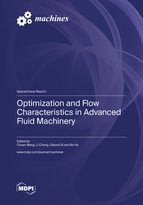Optimization and Flow Characteristics in Advanced Fluid Machinery
A special issue of Machines (ISSN 2075-1702). This special issue belongs to the section "Electromechanical Energy Conversion Systems".
Deadline for manuscript submissions: closed (30 November 2022) | Viewed by 62942
Special Issue Editors
Interests: fluid machinery; optimization design of pumps; internal flow theory of pumps; interference mechanism of jet and rotating fluid
Special Issues, Collections and Topics in MDPI journals
Interests: pump and pump station; internal flow theory of pump
Interests: flow-induced vibration and noise of rotating machinery; multiphase flow in fluid engineering; pump hydraulic design and energy-saving mechanism research
Special Issues, Collections and Topics in MDPI journals
Interests: fluid machinery; flow and heat transfer; flow–structure coupling; multiphase flow
Special Issues, Collections and Topics in MDPI journals
Special Issue Information
Dear Colleagues,
Advanced Fluid Machinery is the key component for the sustainable development of energy and water resources, including various transport processes for liquids. Where fluid flows, fluid machinery works. Therefore, fluid machinery occupies an important position in the social economy. This Special Issue, entitled “Optimization and Flow Characteristics in Advanced Fluid Machinery”, will promote a platform for the sharing of knowledge among researchers in the field of fluid machinery including theoretical analysis, numerical simulation, and experimental study. This Special Issue will cover a wide range of disciplines as follows:
- Optimization of advanced fluid machinery using different advanced algorithms;
- Flow characteristics of advanced fluid machinery using numerical and experimental methods;
- Vibration and noise of advanced fluid machinery;
- Fluid-structural coupling analysis of advanced fluid machinery;
- Cavitation and multi-phase flow of advanced fluid machinery;
- New energy systems, simulation and optimization;
- Other aspects on fluid machinery.
Prof. Dr. Chuan Wang
Prof. Dr. Li Cheng
Prof. Dr. Qiaorui Si
Dr. Bo Hu
Guest Editors
Manuscript Submission Information
Manuscripts should be submitted online at www.mdpi.com by registering and logging in to this website. Once you are registered, click here to go to the submission form. Manuscripts can be submitted until the deadline. All submissions that pass pre-check are peer-reviewed. Accepted papers will be published continuously in the journal (as soon as accepted) and will be listed together on the special issue website. Research articles, review articles as well as short communications are invited. For planned papers, a title and short abstract (about 100 words) can be sent to the Editorial Office for announcement on this website.
Submitted manuscripts should not have been published previously, nor be under consideration for publication elsewhere (except conference proceedings papers). All manuscripts are thoroughly refereed through a single-blind peer-review process. A guide for authors and other relevant information for submission of manuscripts is available on the Instructions for Authors page. Machines is an international peer-reviewed open access monthly journal published by MDPI.
Please visit the Instructions for Authors page before submitting a manuscript. The Article Processing Charge (APC) for publication in this open access journal is 2400 CHF (Swiss Francs). Submitted papers should be well formatted and use good English. Authors may use MDPI's English editing service prior to publication or during author revisions.
Keywords
- Jet Technology
- Pumps
- Compressors
- Turbomachinery System
- Fans and Blowers
- Hydro-turbine
- Propulsion
- Cavitation and Multi-phase Flow
- Renewable Energy
- Optimization









